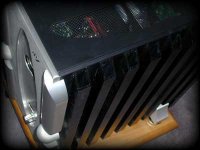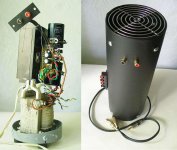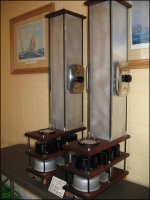It seems to me that most high-end passively-cooled (non-fan) class-A power amplifiers are probably built inside-out with the heat-sinks on the outsides and lying down in the worst horizontal position, making poor use of footprint space. Heatsink on the outside seems natural if you think of how most objects radiate heat. It makes sense...in a windy room. But the interior of the box gets pretty warm. Why do we still make fat squat boxes instead of tall thin ones?
To optimize convection perhaps the box should be vertical instead of lying down, and the heat sink should be a tall pipe sticking out the top, with a removable or telescoping cheap plastic or even cardboard tube as a chimney extension. Seems to me like a big cost savings. That vertical addition sure works for a fireplace LOL but I haven't thought it thru for a heasink "chimney"... Could suck in cold air to keep your filter caps long-lived (I have to think about that...do I want the power supply to be cooled but pre-heat the chimney intake or should the power supply have its own chimney).
I've seen some classy short horizontal "tunnel" aluminum heatsinks for use with fans, with interior fins and nice surfaces for mounting transistors. I think some BGW or Crest amps I used had something like that. I've seen some on large inverters etc. Some are multiple-piece castings. I've seen some in parts catalogs once or twice. Might be adaptable to mounting for vertical airflow instead of fans and convection cooling with the addition of a chimney pipe on the exhaust end?
Maybe it would be interesting to come up with some aluminum extrusion profile with interior (and exterior?) finning optimized for a tall non-fan chimney. Maybe weld on a long block for spreading the heat and mounting the transistors on. Might find something available for some kind of heat exchanger application with internal and external finning? I should go wander the scrap yards and get lucky. Besides optimizing the interior and exterior fin shapes you'd have to balance unimpeded airflow versus turbulance at the surface to aid in the heat transfer; maybe interor fins in some spiral pattern like gun-barrel rifling on steroids? I understand it is possible to extrude aluminum like that, rotating as it comes out the die, though I have no idea whether anyplace is set up to do that. Maybe in a real application some spiral passive stationary fan blades could be inserted inside a chimney tube to make the air spin as it rises (probably does anyway)?
When Nelson Pass talks about heatsinks hot to the touch, I know a good chimney shape will flow a lot of air without having to get that hot, and flow more when hotter kind of like a variable-speed fan meeting changing demand with varying airflow.
Perhaps welding an aluminum block onto a piece of thick-wall tubing with a cheap-material extension might out-perform fancy heat-sinks in the traditional wrong squat fat shape sitting on a shelf or stuck in a cabinet Nelson forbid.
Maybe a vertical pipe chimney heasink could double as a speaker stand or base mount somehow.
Or maybe I'm wrong and everyone else is right.
To optimize convection perhaps the box should be vertical instead of lying down, and the heat sink should be a tall pipe sticking out the top, with a removable or telescoping cheap plastic or even cardboard tube as a chimney extension. Seems to me like a big cost savings. That vertical addition sure works for a fireplace LOL but I haven't thought it thru for a heasink "chimney"... Could suck in cold air to keep your filter caps long-lived (I have to think about that...do I want the power supply to be cooled but pre-heat the chimney intake or should the power supply have its own chimney).
I've seen some classy short horizontal "tunnel" aluminum heatsinks for use with fans, with interior fins and nice surfaces for mounting transistors. I think some BGW or Crest amps I used had something like that. I've seen some on large inverters etc. Some are multiple-piece castings. I've seen some in parts catalogs once or twice. Might be adaptable to mounting for vertical airflow instead of fans and convection cooling with the addition of a chimney pipe on the exhaust end?
Maybe it would be interesting to come up with some aluminum extrusion profile with interior (and exterior?) finning optimized for a tall non-fan chimney. Maybe weld on a long block for spreading the heat and mounting the transistors on. Might find something available for some kind of heat exchanger application with internal and external finning? I should go wander the scrap yards and get lucky. Besides optimizing the interior and exterior fin shapes you'd have to balance unimpeded airflow versus turbulance at the surface to aid in the heat transfer; maybe interor fins in some spiral pattern like gun-barrel rifling on steroids? I understand it is possible to extrude aluminum like that, rotating as it comes out the die, though I have no idea whether anyplace is set up to do that. Maybe in a real application some spiral passive stationary fan blades could be inserted inside a chimney tube to make the air spin as it rises (probably does anyway)?
When Nelson Pass talks about heatsinks hot to the touch, I know a good chimney shape will flow a lot of air without having to get that hot, and flow more when hotter kind of like a variable-speed fan meeting changing demand with varying airflow.
Perhaps welding an aluminum block onto a piece of thick-wall tubing with a cheap-material extension might out-perform fancy heat-sinks in the traditional wrong squat fat shape sitting on a shelf or stuck in a cabinet Nelson forbid.
Maybe a vertical pipe chimney heasink could double as a speaker stand or base mount somehow.
Or maybe I'm wrong and everyone else is right.
Last edited:
The chimney idea sounds good. I guess the main problem is that most people want an amplifier that looks like what they expect an amplifier to look like.... heat-sinks ... convection ... chimney ...
The heatsinks on Nelson's First Watt chassis always look to me like a waste of perfectly good metal.... heat-sinks ... poor use ... convection ... Nelson Pass
Check out Variac's F4 monoblocks.
i.imgur.com/l9kC7.jpg
what exactly is that giant stack on top of the amps supposed to be/do?
_-_-bear
Last edited:
Cyclecamper is right about the whole issue. Normally, you would expect,
that DIY people will have more imagination, than the rigid rules of mass
manufacturing dictate or allow.
Do we need to promote the idea of two monoblocks for power amplication,
and placing those monoblocks near the speakers, having much shorter
speaker cables, and to realize, that since speakers are tall, then the
monoblocks can be tall too, providing this chimney effect naturally by
the properties of the casing.
We can see this approach adopted in some commercial designs, like from
Tim Paravicini.
For illustration here is the pic of a "vertical amp" design inside a long tube,
which was produced by a hobbyist.
that DIY people will have more imagination, than the rigid rules of mass
manufacturing dictate or allow.
Do we need to promote the idea of two monoblocks for power amplication,
and placing those monoblocks near the speakers, having much shorter
speaker cables, and to realize, that since speakers are tall, then the
monoblocks can be tall too, providing this chimney effect naturally by
the properties of the casing.
We can see this approach adopted in some commercial designs, like from
Tim Paravicini.
For illustration here is the pic of a "vertical amp" design inside a long tube,
which was produced by a hobbyist.
Attachments
I imagine something between Variac's Steam-Punk chimneys and a chimney extension of Zen Mod's post and pic:
http://www.diyaudio.com/forums/attachments/pass-labs/111614d1215204042-f4-power-amplifier-one3.jpg
http://www.diyaudio.com/forums/attachments/pass-labs/111614d1215204042-f4-power-amplifier-one3.jpg
Last edited:
One thing I would mention, if yer gonna do this, is put the heatsinks at the bottom. This allows for the highest temperature at the fullest length of air column, maximizing convection force fer a given column height. There is also the issue of dividing the flow properly between the open space and the sink fins, which gets a lot more complicated but is not so bad to optimize by empirical methods if you have the experience or the time to get it. You may wish to put nothing but the sinks in the air column.
Last edited:
Actually, all my amps have fans. But I've become spoiled by the lack of sharp exterior fins. Now that I'm considering convection-cooled amps I'm looking at novel vertical shapes.
StevenOH,
That's interesting. Very interesting to consider where we would mount what parts in an ideal world. Look at how his power supply caps are so close to the output devices. And how high-gain input section is so far from the power transformer. Still I'm not sure I would want the heat from the power supply to pre-heat the chimney. Assuming the temp in the chimney rises with height, I'd want the output devices near the air input to the chimney. But it's not so attracitve to have the heavy power transformer at the top. Variac's layout is interesting, with power supply not in the chimney. I remember the way they used to build computers, like the old GE or the Cray supercomputers. Power supplies at the base around a central chimney of memory. But maybe putting the power transformers and rectifiers in their own remote vertical box is even better.
At the least, I think that if I had some of Nelsons' chassis he gave away at BA (I should have been so lucky), with the side-mounted heat-sinks made of rectangular extrusions, I would just double the length and wall thickness of those extrusions. There have been other commercial monoblocks that are more vertical, and I suppose I should look for them and study what others have done.
StevenOH,
That's interesting. Very interesting to consider where we would mount what parts in an ideal world. Look at how his power supply caps are so close to the output devices. And how high-gain input section is so far from the power transformer. Still I'm not sure I would want the heat from the power supply to pre-heat the chimney. Assuming the temp in the chimney rises with height, I'd want the output devices near the air input to the chimney. But it's not so attracitve to have the heavy power transformer at the top. Variac's layout is interesting, with power supply not in the chimney. I remember the way they used to build computers, like the old GE or the Cray supercomputers. Power supplies at the base around a central chimney of memory. But maybe putting the power transformers and rectifiers in their own remote vertical box is even better.
At the least, I think that if I had some of Nelsons' chassis he gave away at BA (I should have been so lucky), with the side-mounted heat-sinks made of rectangular extrusions, I would just double the length and wall thickness of those extrusions. There have been other commercial monoblocks that are more vertical, and I suppose I should look for them and study what others have done.
Hi all , Cyclecamper, I built a KrellKSA50 clone that i thought I could keep cool passively with large heatsinks running along both sides of the case.It was cool enough for the output devices (about 50c ) but of course everything else within the case got to the same temperature.
So a couple of months ago I ripped it apart and started to construct it in a vertical manner, transformers on the bottom, then rectifier assembly then a Papst 120mm fan and then the heatsink chimney. The fan draws cool air from the base up through the transformers and rectifiers keeping them cool and the passes up the chimney and out the top of the case.
I have promised that I would post some pics on the KSA50 thread as soon as I can.Results in testing look promising so far, but I still have a long way to go and I work quite slowly.
Cheers
Alan
So a couple of months ago I ripped it apart and started to construct it in a vertical manner, transformers on the bottom, then rectifier assembly then a Papst 120mm fan and then the heatsink chimney. The fan draws cool air from the base up through the transformers and rectifiers keeping them cool and the passes up the chimney and out the top of the case.
I have promised that I would post some pics on the KSA50 thread as soon as I can.Results in testing look promising so far, but I still have a long way to go and I work quite slowly.
Cheers
Alan
That link didn't work for me so I uploaded the photo.
It isn't supposed to, it DOES in fact cool the output devices effectively. There is an amp board with 6 MOSFETS under each of those chrome side covers. I used 3/16" thick tube. If I had to do it again I'd use 1/4" to 3/8" because the upper area of the tubes doesn't really get very warm which means the heat isn't spread enough to take full advantage.
Each tower is a 2 ch F-4 amp which I tend to run balanced, which in theory is 100 class A watts! The wood top and bottom plates have a hole the size of the interior of the stack so air can rise through the tube- cooling it. If you add up the sq inches, its quite a bit - even if it doesn't have fins. The air rising up through them does seem to work. One problem with fins is that if the sink is tall they have to be widely spaced. Not a problem with this stack.
Magura misunderstood the kind of Class A amp they were when he said that all those fins were needed-they weren't .
It isn't supposed to, it DOES in fact cool the output devices effectively. There is an amp board with 6 MOSFETS under each of those chrome side covers. I used 3/16" thick tube. If I had to do it again I'd use 1/4" to 3/8" because the upper area of the tubes doesn't really get very warm which means the heat isn't spread enough to take full advantage.
Each tower is a 2 ch F-4 amp which I tend to run balanced, which in theory is 100 class A watts! The wood top and bottom plates have a hole the size of the interior of the stack so air can rise through the tube- cooling it. If you add up the sq inches, its quite a bit - even if it doesn't have fins. The air rising up through them does seem to work. One problem with fins is that if the sink is tall they have to be widely spaced. Not a problem with this stack.
Magura misunderstood the kind of Class A amp they were when he said that all those fins were needed-they weren't .
what exactly is that giant stack on top of the amps supposed to be/do?
_-_-bear
Attachments
Last edited:
Very very interesting, I like a man who thinks. Even the steam-punk appearance will have its fans in contemporary design schools. What's the temp like at different heights, what does your hand feel at the top, how warm or cool does it run and how much air can you feel moving, blowing out the top? Would be interesting to paint with the temp-color-change "thermometer" paints to dramatize the temp change. Do you think it's more imortant to not restrict the flow, or would it help to have some disruption to add turbulance right near the transistors to maximize the heat exchange right there (like insert a stationary fan blade near the midpoint or maybe lower)? Now that you've been there/done that, you endorse thicker aluminum; what about 1/3 the diameter, round section, internal fins, transistors lower nearer the coldest end of the chimney, and the upper half of the chimney made of some much cheaper material like thin plastic pipe or clear acrylic tube? I'm thinking round pipe is an optimum chimney shape, and in standard sizes would mate nicely to clear acrylic tube unless some visiting fool mistakes it for a big bong...jah mahn I put some hashish on those little bumps inside and got a killer hit of smoke, dude... I'd love to build a shortie and experiment with different chimney extensions, and so some experiemental optimization of internal fins/diameter/length etc. I imagine one large chimney per amp will far outperform a bank of smaller chinneys scaled down...much less restriction with the large chimney. Then again, if I have the lower metal section internally-finned, then an unfinned upper plastic pipe might be smaller diameter and get higher velociy of the air, making a better air pump in a given height. I wonder whether at some point it would begin to whistle (only if you spill water inside LOL)? Would definitely be interesting to put a light at the top and blow some smoke into it, just to observe the air flow visually.
Last edited:
- Status
- This old topic is closed. If you want to reopen this topic, contact a moderator using the "Report Post" button.
- Home
- Amplifiers
- Solid State
- Chimney cooling


